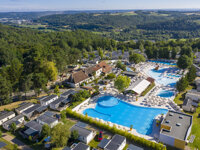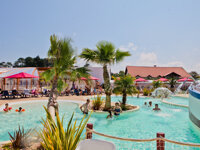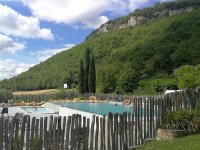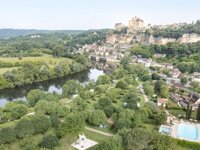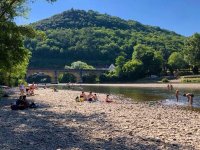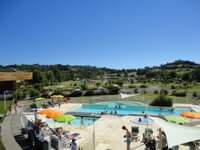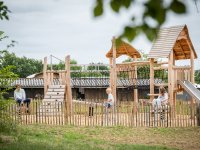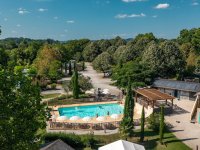
Most Beautiful Villages in Aquitaine
Aquitaine is home to the historic Dordogne, as well as some of the most prestigious vineyards in the world – those of Bordeaux. The latter provides a great cultural experience, with its châteaux set splendidly among the vines and the impressive city of Bordeaux poised at the heart of it all. It is in the Dordogne that some of the most intriguing historical sites can be found. Caves with ancient paintings and mighty stalagmites weave beneath a picturesque countryside, where medieval cities such as Sarlat perch.
Points of interest: Bordeaux | Dune du Pilat | Château de Bonaguil | Saint-Emilion | Biarritz | Sarlat | Brantôme | Lascaux International Center of Parietal Art | The Marqueyssac gardens | Gouffre de Padirac | Rocamadour
Sorry, this map cannot be displayed.
The following consent is required:
Tracking & performance, Targeting & advertising.
Pyrénées-Atlantiques

Ainhoa
Bordering Spain and featured on the Compostela pilgrim route, Ainhoa is a must-visit on any tour of the Basque Country. The village was completely destroyed in the Thirty Years War during the 17th century and entirely rebuilt. Its main street is lined with attractive white, red and green faНades and its 13th century church is worth visiting for its stunning gold altar.

La-Bastide-Clairence
Dating back to the 14th century and resting just 25km southeast of Bayonne lies arguably the most perfectly preserved village in the Basque region. Historically the village was home to Spanish and Portuguese Jews who settled there after fleeing the Spanish inquisition. Its symmetrical arcaded village square is flanked with quaint white houses with red timbering and colourful garlands.
![Navarrenx [📸 les-plus-beaux-villages-de-france.org]](https://static.alanrogers.com/assets/images/campsite/default.png)
Navarrenx
The saying ‘looks can be deceiving’ couldn’t be more true in this instance. Uninviting and cold from outside its military exterior, Navarrenx is quite the opposite on the inside. Its imposing ramparts were built in the 16th century under the direction of Italian architectural engineer Fabricio Siciliano who based it on the citadel of Lucas in Tuscany. It became the first modern, Italian-styled bastioned town in France. It’s also said to be the salmon-fishing capital of France.
![Saint-Jean-Pied-de-Port [📸 Biarritz Pays Basque Tourism] biarritz-pays-basque.com](https://static.alanrogers.com/assets/images/campsite/default.png)
Saint-Jean-Pied-de-Port
Nestling between the Basque hillsides and the Spanish border, on the banks of the river Nive lies the old Basque province capital of the Lower Navarre and famous stop of the Way of St James en route to Santiago de Compostela. Its neat white and red faНades with balconies overlooking the river contrast the striking fortress rebuilt by Vauban what overlooks the town and offers fabulous views over the verdant Basque countryside.

Sare
The small village of Sare rests deep in the Basque country and is backed by the Pyrénées mountains. It shares 25km of border with neighbouring Spain and has long been linked to pastoral agriculture. The surrounding area was briefly exploited for its minerals during the Middle Ages but it now relies mostly on shared tourism with Spain thanks to its proximity and common Basque language. Its traditional houses, pelota court, church of St Martin and unspoilt environment are all add to the charm of the area.
Dordogne

Belvés
Belvés is a lively town with a preserved 15th century covered market hall and an archetypal bastide layout. In its centre the medieval belfry stands proud overlooking the market square which springs into life on Saturday mornings and summer nights during July and August. Its picture-postcard streets (notable streets include Rue du Petit Sol and Rue de l’Oiseau qui Chante which translates to ‘street of the bird that sings’) are often decorated with colourful garlands in the summer months.

Beynac-et-Cazenac
Conjure up an image of the perfect Dordogne village and Beynac-et-Cazenac comes pretty close. Clinging to the side of a cliff, this alluring village with its flower-decked houses, riverside location and dominating castle offers breathtaking views of the valley. In the summer, classical music echoes through the streets as the village hosts music nights.

Castelnaud-la-Chapelle
Walk up cobbled streets, through arches and discover pretty Périgordian stone houses round every corner. Lining a stretch of the Dordogne river, just 10km from Sarlat and perched snug against the steep hillside sits this beautiful village. It’s perhaps most well known for its imposing chateau high up on the hill which silently watches over the valley.

Domme
Not far from Sarlat sits Domme, a small bastide town founded in the late 1200s. The town has a rich but turbulent history and has changed hands several times between the English and French. Most recently, in the second world war the extensive cave network beneath the town was used as a hideout. The town square, caves and spectacular 180 degree views over the Dordogne valley are a short but steep stroll from the original fortified entrance to the town.

La Roque-Gageac
Lining the banks of the Dordogne river lies La Roque-Gageac with its ochre-coloured houses sheltered beneath dramatically overhanging cliffs. Inevitably, the village pulls bus-loads of tourists each summer so its best to visit off season or get away from the bustle of the centre and wander the secret side streets and alleyways which also offer shade from the midday heat.
![Limeuil [📸 Dordogne Périgord Tourism] dordogne-perigord-tourisme.fr](https://static.alanrogers.com/assets/images/campsite/default.png)
Limeuil
Located on the confluence of the Dordogne and Vézère rivers, on the border of the Périgord Pourpre and Périgord Noir just 36km from Sarlat, Limeuil - taken from the Latin ‘Lim lemo’ meaning elm - is a charming rural village. Its honey-coloured stone houses decked with flowers and quaint cobbled streets should be teeming with tourists but the village has escaped its share of bum-bagged, socks-and-sandalled sightseers so make the most of the peaceful atmosphere and laidback pace of life.

Monpazier
In the heart of the Land of the Bastides lies the almost perfectly preserved village of Monpazier, its original aspect and dimensions still intact. Its covered market square hosts an array of stalls every Thursday morning. Its central square is also home to several cafés and restaurants, perfect for evening dining. Event highlights include the Monpazier Flower festival which is held each spring and the Medieval Day in high summer in which residents dress in medieval finery and decorate the town.
![Saint-Amand-de-Coly [📸 Mathieu Anglada] dordognevalleytravel.com](https://static.alanrogers.com/assets/images/campsite/default.png)
Saint-Amand-de-Coly
Saint-Amand rests just 10km from the world famous Lascaux caves in the heart of the Dordogne. It boasts a beautiful fortified Romanesque church which, during the summer months, is a magical venue for concerts. Its location amongst the woods and its architectural heritage make it popular with tourists who flock to the region known for its rich history and superb gastronomy.
![Saint-Jean-de-Cole [📸 guide-du-perigord.com]](https://static.alanrogers.com/assets/images/campsite/default.png)
Saint-Jean-de-Cole
With the River Côte running to the north, Saint-Jean-de-Côle is a small medieval village in the Périgord Vert. Its charming ochre-coloured houses are clustered together around the Roman-Byzantine church.

Saint-Léon-sur-Vézère
Burrowing into the banks of the river Vézère in Périgord Noir, Saint-Léon-sur-Vézère overflows with authenticity and charm. The village church, small but perfectly formed, sits beside the river on the site of an ancient Gallo-Roman villa and you can see some traces of it next to the church. Make sure you take a look inside as the domed ceiling has the remains of some beautiful frescoes.
Lot-et-Garonne
![Monflanquin [📸 guide-du-perigord.com]](https://static.alanrogers.com/assets/images/campsite/default.png)
Monflanquin
Steeped in history and tradition, this hilltop town has hosted a Thursday morning market every week since its founding in 1256! Its gorgeous central square, bordered by arcades with ornate balconies draped with greenery is home to cafés, the tourist office and the Musée des Bastides - an interactive museum offering insight into the fortified medieval towns of southwest France, well worth a visit. In August the Médiévales de Monflanquin festival transports residents and visitors back to the Middle Ages with entertainment, processions, a market and an authentic medieval banquet.
![Pujols-le-Haut [📸 Sylvie - Flickr]](https://static.alanrogers.com/assets/images/campsite/default.png)
Pujols-le-Haut
Perched 180m above sea level and dominating the valleys of the Lot Pujols has retained much of its medieval heritage. The village is laid out around a traditional covered market hall where, every Sunday morning from May to September, a market takes place selling local produce and wares. Saint-Foy church, one of two churches in the village, holds regular art exhibitions and is also home to some impressive 15th century frescoes.
